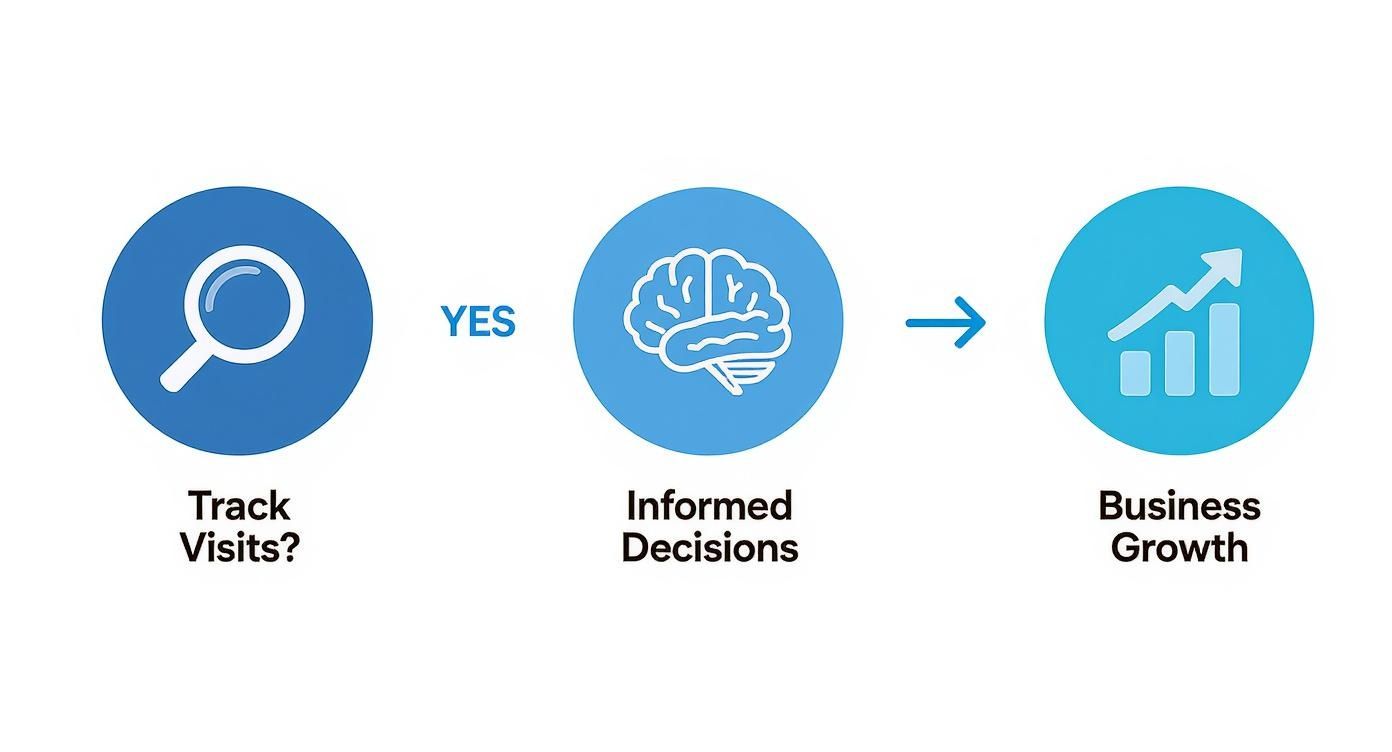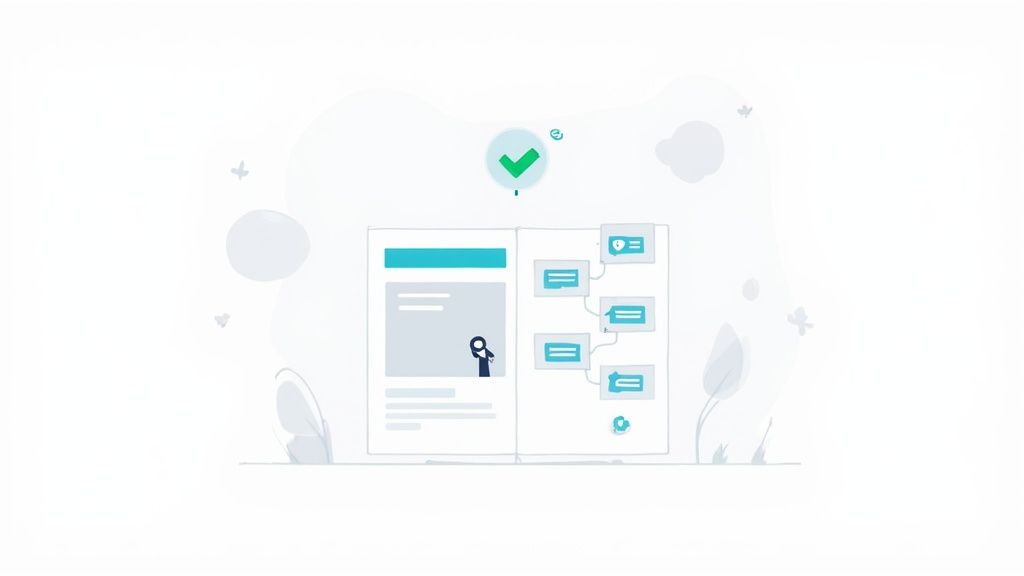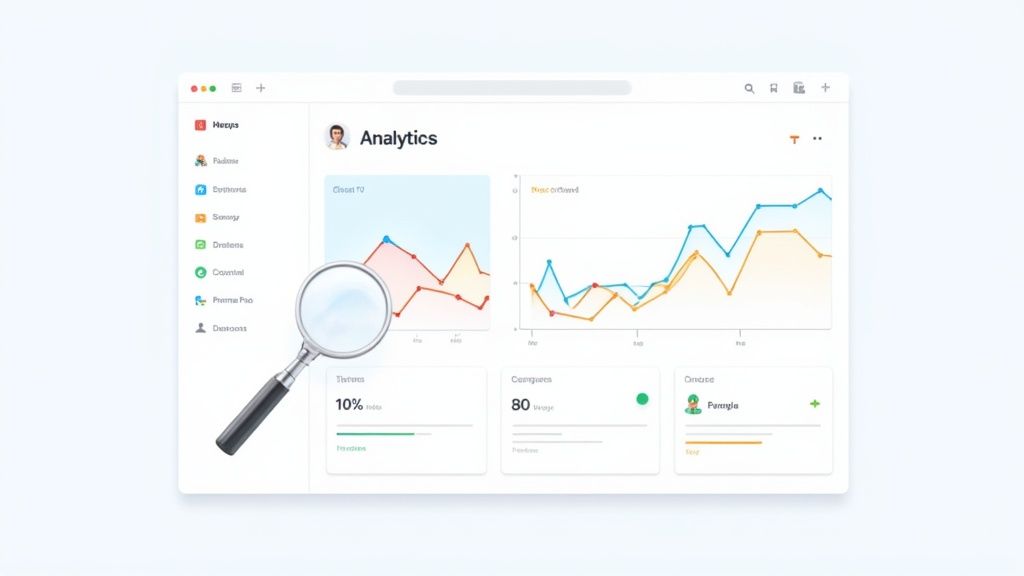- Date
How to Track Visits to a Website
 Andrii Romasiun
Andrii Romasiun
So, how does website visit tracking actually work? At its core, you place a small snippet of code—a tracking script from a web analytics tool—onto your website. This script works behind the scenes to anonymously gather data on what your visitors do, like the pages they browse and how they found you, then sends that info straight to your analytics dashboard.
While Google Analytics is the big name everyone knows, there are plenty of other great, privacy-first alternatives out there today.
Why Tracking Website Visits Drives Growth
Before we get into the nitty-gritty of setting things up, let's talk about why this is so important. Tracking website visits isn't just about watching numbers go up. It’s about understanding the story your audience is telling you with every click and scroll. Flying blind without this data means you're just guessing at what people want.
The insights you get from traffic data can shape your entire business strategy. Imagine you run an e-commerce store and see that a ton of people are abandoning their carts right at the checkout page. By digging into the user journey, you might find a buggy form or a surprisingly high shipping fee. Fixing that one issue could immediately boost your sales.
From Data Points to Strategic Decisions
The real magic happens when you treat this data as a direct feedback loop. Every visit gives you clues about what’s working and what’s falling flat. A blogger might notice their articles on a specific topic get way more traffic from Google than anything else. That's a huge signal telling them exactly what their audience wants to read.
This insight helps them plan future content, focusing their energy on what truly resonates. If you're new to this concept, our guide on **what is web analytics** is the perfect place to get up to speed.
Ultimately, tracking your website’s performance allows you to:
- Understand Your Audience: See where your visitors are from, what devices they're using, and other key demographics.
- Optimize Your Content Strategy: Pinpoint your most popular pages and learn what kind of content keeps people engaged.
- Improve User Experience (UX): Find pages with high bounce rates that might point to design flaws or confusing navigation.
- Maximize Marketing ROI: Figure out which channels—social media, email campaigns, or paid ads—are actually bringing you valuable traffic.
When you connect website tracking to real business goals like better conversion rates and a smarter content plan, it stops being a technical chore. It becomes the engine for growth, giving you the hard evidence you need to make decisions that move your business forward.
Choosing Your Website Analytics Tool
Picking the right platform to track your website visits is the first real crossroads you’ll hit. This isn't just about picking software; the tool you choose dictates how you see your audience, the kind of insights you can pull, and how well you can respect user privacy. Your decision should really boil down to what you want to achieve, your technical comfort level, and where you stand on data privacy.
Think of it this way: tracking your visitors is the first step in a cycle. You track, you learn, you adjust, and you grow.

This process is what turns raw traffic numbers into smart decisions that actually move the needle for your business.
Google Analytics 4: The 800-Pound Gorilla
For years, Google Analytics has been the default choice for, well, almost everyone. Its latest iteration, Google Analytics 4 (GA4), is a seriously powerful, event-based platform. It's designed to go way beyond just counting pageviews to track meaningful user interactions like button clicks, video plays, and form submissions. This gives you a much clearer picture of what people are actually doing on your site.
Since its debut back in 2005, Google Analytics has become the most common way people track website visits. It’s used on over 29 million websites, all powered by a small JavaScript snippet that sends data back to Google’s servers. It lets you see everything from real-time visitor counts and demographics to session duration and traffic sources.
GA4's power is undeniable, but it comes with a steep learning curve. The sheer depth of its features can be overwhelming if you're just starting out. Plus, its data collection methods are a growing privacy concern for many businesses and their customers.
Privacy-First Analytics: The Modern Alternative
With regulations like GDPR tightening the screws and users becoming more savvy about their data, a new wave of analytics tools has surfaced. These platforms are built from the ground up with privacy in mind, often forgoing cookies entirely and anonymizing all data.
Tools like Matomo, Fathom, and our own Swetrix offer a fantastic alternative. They give you the essential metrics you need to make good decisions, but without collecting personally identifiable information (PII). This isn't just about compliance; it's about building trust with your audience.
My Takeaway: You don’t have to sacrifice insights to be ethical. Choosing a privacy-first tool gives you the actionable data you need while keeping you compliant and respecting your visitors.
These tools are also typically much simpler to navigate, with clean dashboards that get straight to the point. If you want to dig deeper into the options, our guide on the **top 10 site analytics tools** is a great place to start.
Making Your Decision
So, which path is right for you? It really comes down to your priorities. To help you weigh your options, I've put together a quick comparison of some of the top players in the space.
Comparison of Top Website Analytics Tools
This table breaks down the key features, pricing, and ideal use cases for some leading analytics platforms to help you find the perfect fit.
| Tool | Key Feature | Pricing Model | Best For |
|---|---|---|---|
| Google Analytics 4 | Deep integration with Google Ads & event-based tracking | Free (with paid options for very large sites) | Businesses heavily invested in the Google ecosystem that need granular, complex data. |
| Swetrix | Lightweight, open-source, and privacy-focused with a clean UI | Freemium (Free plan available, paid for more features) | Developers and businesses prioritizing user privacy and a simple, fast interface. |
| Matomo | Self-hosting option for full data ownership and control | Freemium (Cloud or On-Premise) | Organizations with strict data sovereignty requirements or those wanting full control. |
| Fathom | Extremely simple, cookie-less, and bypasses ad-blockers | Paid (Subscription-based) | Bloggers, freelancers, and small businesses who want simple, reliable, and compliant analytics. |
Ultimately, the best tool is the one that gives you clear, actionable insights without becoming a compliance nightmare or a technical burden.
Here’s a simple breakdown to guide your choice:
- Go with Google Analytics if: You need incredibly detailed data, you rely on Google's advertising network, and you have the time or team to manage its complexity.
- Choose a privacy-first tool if: GDPR compliance is a top priority, you prefer a clean and intuitive dashboard, and you want to build your brand on a foundation of trust and ethical data handling.
Getting Your Tracking Code on Your Website

Alright, you've picked your analytics tool. Now for the crucial part: actually connecting it to your website so it can start working its magic. This connection is made with a small piece of JavaScript, usually called a tracking script or a "tag." Think of it as a tiny messenger that observes what happens on your site and reports back to your analytics dashboard.
You’ve got two main ways to get this done: you can either put the code directly into your website's files or use a tag management system. Honestly, the right choice really boils down to your comfort level with code, how complex your site is, and how much you plan to track in the future.
The Direct Method: Quick and Simple
For most people, especially if you're using a platform like WordPress or Shopify, just adding the code directly is the fastest way to get up and running. Your analytics provider will hand you a code snippet, and your job is to paste it into the <head> section of your website’s HTML.
This approach is straightforward and works perfectly for basic tracking. The script loads on every single page, so you won’t miss any visitor data.
The downside? It’s not very flexible. If you want to add another tracking script later—like a Facebook Pixel or a heat mapping tool—you have to dive back into your website's code. This can get messy fast, and if you aren't a developer, it can feel a bit daunting.
The Power User Method: Using a Tag Manager
For a more robust and scalable setup, I almost always recommend a tag management system like Google Tag Manager (GTM). It’s a game-changer. Instead of adding a bunch of different scripts to your site, you just add one—the GTM container. From that point on, you manage all your other tags (like your analytics script) from inside the GTM dashboard.
Why is this so much better?
- You don’t touch your site’s code again. Need to add a new tool? Just pop the tag into GTM. No developer needed.
- Everything is in one place. Your analytics, ad pixels, and other tracking scripts are all neatly organized in one spot.
- It unlocks advanced tracking. GTM makes it so much easier to track specific actions, like when someone clicks a certain button or fills out a form, using its system of triggers and variables.
Here's an analogy I like to use: The direct method is like wiring every lamp in your house directly into the wall. A tag manager is like installing a central breaker box—you can control everything from one place without having to rip open the walls.
Don't Skip This: Always Verify Your Setup
No matter which path you take, this last step is non-negotiable. You have to make sure the code is actually working. Don't just install it and hope for the best.
Pretty much every analytics tool has a "Real-time" report. After you've installed your code, open your website in a new browser tab or on your phone. Then, check the real-time report. You should see yourself pop up as an active visitor within a minute or two.
This simple check gives you peace of mind that your data is accurate from day one. If you want to dive deeper into how this all works behind the scenes, you can learn more about the technical details of a **tracking script** and what makes it tick.
Making Sense of Your Core Website Metrics

Alright, your tracking code is up and running, and the data is beginning to trickle in. The first time you open that analytics dashboard, it can feel like you’re trying to read a foreign language. It's just a wall of numbers and charts.
The secret isn’t memorizing definitions. It’s about learning to see the story behind the data. These metrics are how your visitors tell you what’s working, what’s confusing, and where they’re giving up.
The Foundational Metrics: Who, How Often, and How Much?
Let's start with the big three: Users, Sessions, and Pageviews. Think of them as the basic building blocks of your traffic story.
- Users: This is the count of unique individuals who dropped by. If the same person visits your site on Monday and again on Friday, they still only count as one user for that week.
- Sessions: This is a single, continuous visit. That same person visiting on Monday and Friday? That's two separate sessions. A session usually times out after 30 minutes of inactivity.
- Pageviews: This is the grand total of pages viewed across all sessions. If a user lands on your homepage, clicks to your "About" page, and then views a product, that single session generated three pageviews.
These numbers give you a quick snapshot of your site's overall activity. But the real magic happens when you start digging deeper into how visitors are actually behaving.
Going Beyond Counts to Understand Behavior
This is where we move from just counting traffic to understanding its quality. Metrics like Bounce Rate and Session Duration tell you a ton about whether you’re attracting the right audience and if your content is actually resonating.
A Bounce Rate is the percentage of people who land on a page and leave without doing anything else. No clicks, no scrolling, no interaction—they just "bounce."
Now, a high bounce rate isn't automatically a disaster. If someone finds the answer they need on a single blog post and leaves satisfied, that's a win! But if you see a sky-high bounce rate on a key landing page, you’ve got a problem. It could mean your ad copy doesn't match the page, the design is clunky, or the page loads too slowly.
The goal isn’t just to get people to your site; it’s to get the right people there and give them a reason to stick around. A low bounce rate paired with a high average session duration is a fantastic sign that your content is hitting the mark.
Pinpointing Your Best Traffic Sources
Let's be honest: not all traffic is created equal. One of the most powerful things analytics can tell you is where your visitors are coming from. This is how you discover what's working and where to invest your marketing budget.
Are people finding you through Google? Are your social media posts actually driving clicks? Is that guest post you wrote last month sending any valuable traffic your way?
Your traffic source report holds the answers. For example, industry data shows that direct traffic (people typing your URL directly) often accounts for a huge chunk of visits—around 58%—which points to strong brand awareness. Organic search is typically next at 29%, with referrals and social media trailing at 8% and 2%. You can get a more detailed look at these numbers over at Emailvendorselection.com.
By digging into your sources, you can find out:
- If your SEO efforts are paying off with a steady stream of organic visitors.
- Which social media platform is worth your time and energy.
- Which partnerships or referral sites send the most engaged users.
This data is your roadmap. It shows you exactly where to double down and where to pull back.
Using Advanced Tracking for Deeper Insights
Once you have a handle on the basic traffic numbers, it's time to dig deeper. Counting visits is a great start, but the real magic happens when you start measuring the actions that actually grow your business. This is where advanced tracking comes into play, helping you shift from simply knowing how many people visit to understanding what your most valuable visitors are doing.
This process starts with setting up goals or conversions. Think of these as the finish lines on your website—the specific actions that turn a casual browser into a genuine lead, a loyal subscriber, or a paying customer.
Defining and Tracking Conversion Goals
A "conversion" doesn't always mean a sale. It's any meaningful interaction that nudges a visitor down the path you want them to take. The first step is to clearly define what success looks like for your website and then tell your analytics tool to keep an eye on those specific milestones.
Here are a few common examples of conversion goals I see all the time:
- Form Submissions: A visitor fills out your contact form or requests a product demo.
- Newsletter Sign-ups: You capture an email address for your marketing list.
- Account Registrations: Someone creates a profile or signs up for your service.
- Content Downloads: A user downloads a whitepaper, case study, or free guide.
Once you start tracking these, your analytics dashboard becomes so much more than a simple traffic report. It transforms into a performance tool that shows you which marketing channels are bringing in high-quality leads, not just a high volume of clicks.
Shifting your focus from tracking visits to tracking conversions is a game-changer. It’s the difference between measuring your website’s popularity and measuring its actual impact on your bottom line.
Monitoring User Interactions with Event Tracking
While goals are great for tracking major milestones, event tracking lets you get even more specific. It gives you the power to monitor smaller, individual interactions that happen on a page, offering a much richer picture of user engagement.
With event tracking, you can finally answer questions like:
- How many people actually click the "Play" button on our homepage video?
- Which of our call-to-action (CTA) buttons gets the most clicks?
- Are people engaging with that interactive pricing slider we built?
- How many visitors download our PDF product brochure from the features page?
Getting events set up usually involves adding a few lines of code or using a tool like Google Tag Manager to define which actions to watch. The insights you get from this are pure gold for optimizing your page layouts and making meaningful improvements to the user experience.
Don't Forget Mobile-Specific Behavior
It's a huge mistake to assume that desktop and mobile users behave the same way. The user journey can be wildly different depending on the device, so it’s crucial to segment your data and analyze mobile behavior on its own. A mobile user might be far more likely to tap a "click-to-call" button, whereas a desktop user might take the time to fill out a detailed form.
The numbers don't lie. According to StatCounter Global Stats, as of April 2025, mobile devices drove about 59.7% of all website visits worldwide. That's a massive increase from just 35% back in 2015. This trend shows that for a huge chunk of your audience, their phone is their primary way to browse and buy. Your tracking strategy needs to reflect that reality. For a deeper dive, check out the latest mobile traffic statistics on Tekrevol.com.
Got Questions About Website Tracking?
Even with the best tools, you're bound to have questions as you start digging into your website's traffic data. Let's walk through a few common sticking points to help you feel more confident about the numbers you're seeing.
Is It Possible to Track Website Visitors Without Cookies?
Yes, absolutely. A growing number of privacy-first analytics tools are moving away from cookies entirely. Instead of storing data on a visitor's device, they use other methods to get the job done.
One popular technique involves creating an anonymous "hash" using a visitor's IP address and browser info. This allows the system to recognize a unique visit without holding onto any personal data. It’s a great way to stay compliant with privacy regulations like GDPR while still getting a solid picture of your traffic.
While this cookieless approach might not track a single person's return visits with the same pinpoint accuracy as cookie-based methods, it's a fantastic, privacy-respecting alternative.
How Long Does It Take for New Data to Show Up?
Good news here. Once you've got your tracking code installed, most analytics platforms will start showing activity in a "Real-time" report almost immediately—often within a few minutes. This is your go-to for making sure everything is connected and working correctly right after setup.
But for the more detailed, comprehensive reports (think audience demographics or traffic channel performance), you'll need a bit more patience. It typically takes 24 to 48 hours for all that data to be fully processed and populate your main dashboards. My advice? Always give it at least a full day before you start drawing any major conclusions.
A common source of confusion is the difference between 'Users' and 'Sessions'. Here’s the simple way to think about it: a 'User' is the individual person, and a 'Session' is one of their visits. One user can have multiple sessions.
For instance, if someone (one user) pops onto your site in the morning and clicks through a few pages, that’s one session. If that same person returns in the evening to read your blog, that's a second session. Nailing this distinction is fundamental to understanding your traffic flow correctly.
Ready to track your website visits without compromising user privacy? Swetrix offers a clear, cookie-free analytics platform that gives you the insights you need to grow. Start your 14-day free trial today at https://swetrix.com.